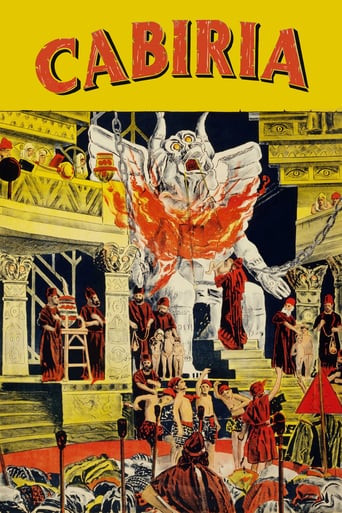

Simple and well acted, it has tension enough to knot the stomach.
... View MoreThis movie was so-so. It had it's moments, but wasn't the greatest.
... View MoreThis is one of the few movies I've ever seen where the whole audience broke into spontaneous, loud applause a third of the way in.
... View MoreIt really made me laugh, but for some moments I was tearing up because I could relate so much.
... View MoreIt's amazing how fast cinema progressed--only about twenty years ago, films were new and consisted of no plot at all--not only this, they were only about a minute long each! Now, here in 1914 we're witnessing a 2-hour spectacle by the Italian filmmaker Giovanni Pastrone that is so sophisticated that at times it gets rather confusing. There are a couple special effects here and there as well as great sets and cool costumes, and put together we've got a pretty fascinating film that met with great success.Despite the title, however, Cabiria is certainly not the main focus here; in fact, we don't even see her for half the film. There are all these different story lines that merge into one as the film continues. While very watchable today, some viewers will find it confusing and a bit dull--but that's only because most people can't sit through two hours of silent film. Probably the film's main issue in terms of story-telling is that it is a little hard to follow. We switch locations constantly, and here and there they throw in pieces of history. Closeups are included, but many of the shots are medium length. What really makes it groundbreaking is its use of panning shots. Panning such as this was rarely used even by 1914 and at times we seem to be approaching the characters which is something I believe I've never seen before in the silent era.Cabiria, the young girl of the title, and her nurse, Croessa, are quite happy when a volcanic eruption of Mt Etna occurs which forces the village to retreat. Pirates discover them, they are sent to become sacrifices for Moloche. But, by the help of two Roman spies, Cabiria is saved--and after this little is heard of her. As for the rest of the movie, we've got all these other story lines and then they eventually build up to the finale.Like I said, a tad confusing at times, but amazing for 1914 and you can see what they mean when they say Griffith turned "The Mother and the Law" into "Intolerance". A real step forward in filmmaking.
... View MoreVolcanoes, earthquakes, pirates, fire sacrifices, elephants in the Alps, camels in the deserts, ships all over the place, a heat ray, secret messages in poisoned jewelery, the first film appearance of Maciste/Hercules in a sword-and-sandal movie: what's not to enjoy? It's just unbelievable that this movie is almost a hundred years young.Well, there's a bit not to like. The first time I saw this, I spent most of the movie trying to figure out if Bartolomeo Pagano was really black. I don't think so, but am not really sure about that. If he wasn't, then it is off-putting to have a white star in black-face (in his case, 'black-body') with real black actors as extras. There's that plus some anti-Semitism, not to mention all the fascist salutes. These were the times during which the film was made.The first time around, the Moloch scene is horrifying on its own, and...***spoiler alert***...you're cheering on the heroes as they save the child. The second time around, after more thought, it's the invocation to Moloch that's so incredibly creepy against the perspective of all the young lives that would soon be offered up on battlefields throughout Europe (including Italy) in the upcoming 20th century wars.The storming of the city of Cirta near the end of the film is okay, but one can imagine D.W. Griffith sitting through it thinking, "I can do a battle-on-the-city-ramparts scene better." He did, too, with the storming of Babylon in "Intolerance." However, he didn't have Sophonisba. She makes a late appearance in "Cabiria," but...***spoiler coming up***...her death scene ends the film perfectly. And she makes another appearance at the very end. Yay!It's still an incredibly good movie, well worth watching.
... View MoreThis is one grand looking and made movie, with plenty of mass sequences, impressive sets and costumes and a story that just screams epic.It's pretty nice to see how some early film-makers got influenced by this movie. Film-makers such as Fritz Lang, D.W. Griffith, who were also all pioneers by themselves. They were obviously inspired by some of the sequences, its scale, sets and compositions, since this movie in some of its sequences show some definite similarities to some sequences in movies such as "Metropolis" and "Intolerance: Love's Struggle Throughout the Ages". Only in that regard you can already call this movie an innovative and important movie. Its sets, compositions and just overall way of story-telling were all quite new and innovating for its time. It's also the first ever movie to use a dolly-track system, which provides the movie with a couple of nice moments as well.The movie its story is very epic, since it's set at many different locations, with also many different characters. It features historical well known figures such as Hannibal, Hasdrubal, Scipio, Archimede, Massinissa, which makes the movie real interesting but is also one of its weaker points, since it makes the movie and its story-telling a bit disjointed at parts.It perhaps also makes the movie feel overlong in parts, even though the movie is only about 2 hours long (well, depending on which version you'll watch), which is actually quite short for an epic movie, especially for one that got made early in the 20th century. 4 hour epics from the same time period are no rarity. The movie just goes on for a bit too long with some of its sequences. After a while you get the point but the scene will just go on and on. It doesn't always makes this an easy but pleasant movie to watch.But overall the movie of course is pleasant as well as impressive, not only because of its visuals but also because of its story that is actually quite adventurous, as long as it knows to focus on the movie its key players. It's adventurous in the same way as a movie like "Ben-Hur" for instance.Also especially when you realize that this is an 1914 movie, it's a real excellent, innovative and interesting, fun movie to watch.8/10http://bobafett1138.blogspot.com/
... View MoreCABIRIA is perhaps the first huge spectacular movie epic and the title of the film is derived from the name of a small girl. The film begins with her miraculous survival from a very realistic eruption of a volcano and takes her on a boat ride to Carthage--Rome's arch-rival during the years of the Republic. Here, she is sold into slavery and is slated to be sacrificed to the evil god, Moloch. The scene of Moloch's temple and the baby-eating idol is truly amazing and horrifying. It must have cost a small fortune to construct. Cabiria is rescued by a Roman spy. However, while she is not killed, she remained a slave for a decade. Eventually, when Rome gained the upper hand in the Punic Wars (with Carthage), Cabiria was saved and everyone lived happily ever after.Now as to why the movie was made in Italy at that particular time, this film came just after Italy successfully attacked North Africa and seized colonies. This film, then, is a sort of justification for this action--as it paints the Carthaginians as baby-sacrificing and evil. Only after the good Romans conquer them is peace and justice restored! This means that this film was one of the earlier propaganda pieces ever put on film and it came out just before the First World War.When you watch CABIRIA, you need to understand the context of when it was made to truly appreciate the film. While the acting might seem over-the-top at times, for 1914 it was a truly amazing film. Never before had a film been so dramatic or had sets to equal this. In fact, the spectacular nature of this Italian film had a strong impact on the films of D. W. Griffith, as it wasn't until 1915 that his huge epic BIRTH OF A NATION and 1916 when INTOLERANCE were released---and they were obviously strongly inspired by CABIRIA. While INTOLERANCE is quite similar to CABIRIA in spots, INTOLERANCE has even grander sets and special effects though the story itself was neither as involving nor as interesting--being muddled quite a bit by having four stories overlapping and the over-the-top moralizing Griffith was known for in many of his films. Instead, CABIRIA is much more straight-forward and interesting storytelling and compares very well to later epics--even some of the sound epics. Sure, by later standards it might seem hokey in spots, but for 1914 it was a huge leap forward in entertainment and is a must-see for all serious film historians.By the way, this review is based on the recent Kino Video restoration. Shorter versions do exist and the Kino version is apparently the closest to the original you can find.
... View More